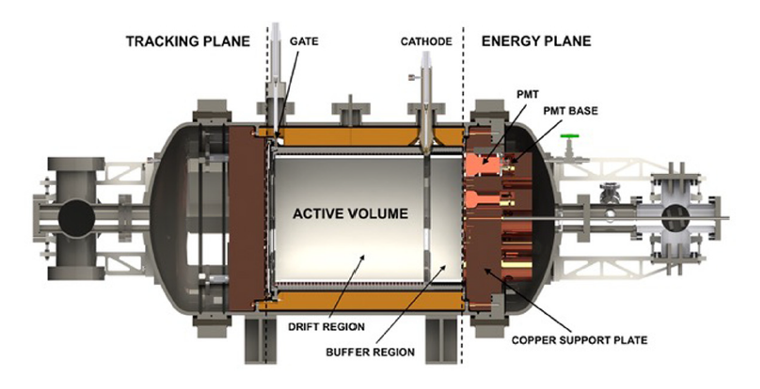Two-neutrino double-β-decay half-life via direct background subtraction
Concluding that the neutrino is a Majorana particle would be really a turning point in our understanding of the universe. It would mean the non-conservation of a magnitude called the leptonic number, one of the key characteristics in a fermion, meaning that there would be an explanation to the matter-anti matter asymmetry: the creation of slightly different amounts of matter and antimatter in the Big Bang that, once annihilation finished, left a small amount of standard matter that we call our observable universe. Nobel-Prize-worth stuff.
Hence, observation of the neutrinoless double beta decay is the only practical way to establish that neutrinos are their own antiparticles. But, because of the small masses of neutrinos, the lifetime of neutrinoless double beta decay is expected to be at least ten orders of magnitude greater than the typical lifetimes of natural radioactive chains, which can mimic the experimental signature of neutrinoless double beta decay. Therefore, the most robust identification of neutrinoless double beta decay requires the definition of a signature signal—such as the observation of the daughter atom in the decay—that cannot be generated by radioactive backgrounds, as well as excellent energy resolution.
All double beta experiments are built with ultrapure materials, operate in underground laboratories (to mitigate the impact of cosmic rays) and are protected by massive, ultrapure shields. These strategies reduce the ambient background by many orders of magnitude, but putative neutrinoless double beta decay events must still be extracted against tens of millions of spurious interactions.
Double beta decay experiments have been searching for neutrinoless events in several isotopes for more than half a century, without finding clear evidence of a signal so far. The current best lower limit on the lifetime of the neutrinoless double beta decay processes has been obtained for an isotope of xenon, 136Xe.
Measuring double beta decay with 2 neutrinos is, so to speak, showing that you can measure the double beta decay process without neutrinos, which is actually easier to measure, or would be, if they had the same half-life. But the two-neutrino double beta decay process has a half-life of 1021 years (that is, 11 orders of magnitude more than the life of the Universe) and the neutrinoless double beta decay process 1027 or 1028, that is, between 1 and 10 million times slower, That’s what makes it really hard.
The double beta decay in 136Xe has been already observed, mainly following a calorimetric approach. In another nongeochemical measurements the half-life of this process has been measured relying on background models derived from the screening of the detector materials and Monte Carlo simulations. The rates of double beta and background events are extracted by comparing such models to the observed data. This background-model-dependent approach is also followed in the search for neutrinoless double decay, providing results that might depend on the background assumptions adopted, such as the number, type, or spatial origin of the different sources. This arises as a possible limitation for next-generation experiments because, when the background can provide one count per tonne every year, new background sources of unknown origin and/or complex modeling become relevant.

We find a way to substract the background deep below the Spanish side of the Pyrenees, where we find the LSC (Laboratorio Subterráneo de Canfranc – Canfranc Underground Laboratory), and the NEXT experiment is taking place. The NEXT technology offers the capability to perform a direct background subtraction, regardless of the origin or number of the specific sources, by combining 136Xe-enriched and 136Xe-depleted data.
Now, a team of scientists has just done that 1 using data from the NEXT-White detector, that was operated at the Laboratorio Subterráneo de Canfranc from 2016 to 2021. NEXT is the third experiment in the world to make this measurement and the first to do it in xenon gas (as well as being the first to measure the process with very little mass, 3.5 kg).
This is the first experiment that obtains results directly from the data, without the need to use a Monte Carlo simulation. The procedure seems simple: first take data with xenon without the 136Xe (depleted); then, with 136Xe (enriched); and subtract! This way, we get the neutrinoless double beta decay signal almost directly.
A similar approach may be exploited to conduct background-independent neutrinoless double beta decay searches in current- and future-generation detectors.
Author: César Tomé López is a science writer and the editor of Mapping Ignorance
Disclaimer: Parts of this article may have been copied verbatim or almost verbatim from the referenced research paper/s.
References
- The NEXT Collaboration (2022) Measurement of the 136Xe two-neutrino double-β-decay half-life via direct background subtraction in NEXT Physical Review C doi: 10.1103/PhysRevC.105.055501 ↩